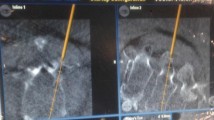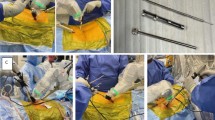Abstract
Purpose
In the field of spinal surgery, 3D-fluoroscopy navigation-assisted pedicle screw (PS) insertion with intra-operative 3D-image control represents a modern application of contemporary navigation technology. In literature, sectional or vertebral accuracy limitations of this image-guidance approach are not profoundly specified. This observational study explicitly differentiates accuracy rates and misplacement mode between spinal sections and single vertebrae from T10 to S1 using a navigation-assisted approach.
Methods
From February 2011 through July 2015, all 3D-fluoroscopy navigation-assisted, 3D-image controlled PS insertions from T10 to S1 were prospectively recorded and evaluated for PS insertion depth, angulation, and entering-point modifications after intraoperative O-arm control scanning. Major complications requiring revision surgery for neurological damage/major bleedings, and procedure-related unintended violations of anatomical structures were recorded.
Results
In 1547 navigation-assisted PS insertions, thoracolumbar accuracy (96.4%) was significantly higher than sacral accuracy (92.6%, p ≈ 0.007) due to special requirements to exact PS (insertion depth) in S1 (p < 0.001). Vertebrae with modification rates above average were identified (T10, L5-S1) (p < 0.001). Major complications did not occur, anatomical structures were violated in 1.2% (19/1547 PS insertions).
Conclusions
In navigation-assisted O-arm-controlled PS placements, correct PS insertion depths are less easily to achieve than correct trajectory or entering-points, which is important for bicortical PS anchorage in S1. Therefore, post-instrumentation PS control by 3D-imaging or at least intraoperative fluoroscopy is recommended for levels with special requirements to exact PS insertion depths (e.g. S1).

Similar content being viewed by others
References
Kosmopoulos V, Schizas C (2007) Pedicle screw placement accuracy: a meta-analysis. Spine 32:E111–E120
Zdichavsky M, Blauth M, Knop C, Lotz J, Krettek C, Bastian L (2004) Accuracy of pedicle screw placement in thoracic spine fractures. Part II: a retrospective analysis of 278 pedicle screws using computed tomographic scans. Eur J Trauma 30:241–247
Laine T, Lund T, Ylikoski M, Lohikoski J, Schlenzka D (2000) Accuracy of pedicle screw insertion with and without computer assistance: a randomized controlled clinical study in 100 consecutive patients. Eur Spine J 9:235–240
Fan Chiang CY, Tsai TT, Chen LH, Lai PL, Fu TS, Niu CC, Chen WJ (2012) Computed tomography-based navigation-assisted pedicle screw insertion for thoracic and lumbar spine fractures. Chang Gung Med J 35(4):332–338
Farber GL, Place HM, Mazur RA, Jones DE, Damiano TR (1995) Accuracy of pedicle screw placement in lumbar fusions by plain radiographs and computed tomography. Spine 20(13):1494–1499
Berlemann U, Heini P, Müller U, Stoupis C, Schwarzenbach O (1997) Reliability of pedicle screw assessment utilizing plain radiographs versus CT reconstruction. Eur Spine J 6:406–410
Rao G, Brodke DS, Rondina M, Bacchus K, Dailey AT (2003) Inter- and intraobserver reliability of computed tomography in assessment of thoracic pedicle screw placement. Spine 28(22):2527–2530
Silbermann J, Riese F, Allam Y, Reichert T, Koeppert H, Gutberlet M (2011) Computer tomography assessment of pedicle screw placement in lumbar and sacral spine: comparison between free-hand and O-arm based navigation techniques. Eur Spine J 20:875–881
Beck M, Mittlmeier T, Gierer P, Harms C, Gradl G (2009) Benefit and accuracy of intraoperative 3D-imaging after pedicle screw placement: a prospective study in stabilizing thoracolumbar fractures. Eur Spine J 18(10):1469–1477
Schnake KJ, König B, Berth U, Schröder RJ, Kandziora F, Stöckle U, Raschke M, Haas NP (2004) Accuracy of CT-based navigation of pedicle screws in the thoracic spine compared with conventional technique. Unfallchirurg 107:104–112
Tormenti M, Kostov DB, Gardner PA, Kanter AS, Spiro RM, Okonkwo DO (2010) Intraoperative computed tomography image-guided navigation for posterior thoracolumbar spinal instrumentation in spinal deformity surgery. Neurosurg Focus 28(3):E11
Larson AN, Santos ERG, Polly DW Jr, Ledonio CG, Sembrano JN, Mielke CH, Guidera KJ (2012) Pediatric pedicle screw placement using intraoperative computed tomography and 3-dimensional image-guided navigation. Spine 37:E188–E194
Panjabi MM, O’Holleran JD, Crisco JJ 3rd, Kothe R (1997) Complexity of the thoracic spine pedicle anatomy. Eur Spine J 6(1):19–24
Tian NF, Xu HZ (2009) Image-guided pedicle screw insertion accuracy: a meta-analysis. Int Orthop 33:895–903
Amiot LP, Lang K, Putzier M, Zippel H, Labelle H (2000) Comparative results between conventional and computer-assisted pedicle screw installation in the thoracic, lumbar, and sacral spine. Spine 25(5):606–614
Holly LT, Foley KT (2003) Intraoperative spinal navigation. Spine 28:54–61
Shin MH, Ryu KS, Park CK (2012) Accuracy and safety in pedicle screw placement in the thoracic and lumbar spines: comparison study between conventional C-arm fluoroscopy and navigation coupled with O-arm® guided methods. J Korean Neurosurg Soc 52:204–209
Van de Kelft E, Costa F, Van der Planken D, Schils F (2012) A prospective multicenter registry on the accuracy of pedicle screw placement in the thoracic, lumbar, and sacral levels with the use of the O-arm imaging system and StealthStation Navigation. Spine 37(25):E1580–E1587
Waschke A, Walter J, Duenisch P, Reichart R, Kalff R, Ewald C (2013) CT-navigation versus fluoroscopy-guided placement of pedicle screws at the thoracolumbar spine: single center experience of 4,500 screws. Eur Spine J 22:654–660
Gelalis ID, Paschos NK, Pakos EE, Politis AN, Arnaoutoglou CM, Karageorgos AC, Ploumis A, Xenakis TA (2012) Accuracy of pedicle screw placement: a systematic review of prospective in vivo studies comparing free hand, fluoroscopy guidance and navigation techniques. Eur Spine J 21:247–255
Rivkin MA, Yocom SS (2014) Thoracolumbar instrumentation with CT-guided navigation (O-arm) in 270 consecutive patients: accuracy rates and lessons learned. Neurosurg Focus 36(3):E7. doi:10.3171/2014.1.FOCUS13499
Kleck CJ, Cullilmore I, LaFleur M, Lindley E, Rentschler ME, Burger EL, Cain CM, Patel VV (2016) A new 3-dimensional method for measuring precision in surgical navigation and methods to optimize navigation accuracy. Eur Spine J 25(6):1764–1774
Zausinger S, Scheder B, Uhl E, Heigl T, Morhard D, Tonn JC (2009) Intraoperative computed tomography with integrated navigation system in spinal stabilizations. Spine 34(26):2919–2926
Mathew JE, Mok K, Goulet B (2013) Pedicle violation and navigational errors in pedicle screw insertion using the intraoperative O-arm: a preliminary report. Int J Spine Surg 7:e88–e94
Nottmeier EW, Seemer W, Young PM (2009) Placement of thoracolumbar pedicle screws using three-dimensional image guidance: experience in a large patient cohort. J Neurosurg Spine 10(1):33–39
Author information
Authors and Affiliations
Corresponding author
Ethics declarations
Conflict of interest
The author declares that there is no competing interest.
Funding
None were declared.
Disclosures
The device (O-arm) is FDA-approved or approved by corresponding national agency for this indication. This research was not sponsored by an organization. The authors declare that they have full control of all primary data and that they allow the journal to review their data if requested. Thomas R. Blattert has received honoraria from AOSpine, Aesculap, Medtronic, SponTech, and Magnifi. For the remaining author none were declared.
Rights and permissions
About this article
Cite this article
Balling, H., Blattert, T.R. Rate and mode of screw misplacements after 3D-fluoroscopy navigation-assisted insertion and 3D-imaging control of 1547 pedicle screws in spinal levels T10-S1 related to vertebrae and spinal sections. Eur Spine J 26, 2898–2905 (2017). https://doi.org/10.1007/s00586-017-5108-5
Received:
Revised:
Accepted:
Published:
Issue Date:
DOI: https://doi.org/10.1007/s00586-017-5108-5




